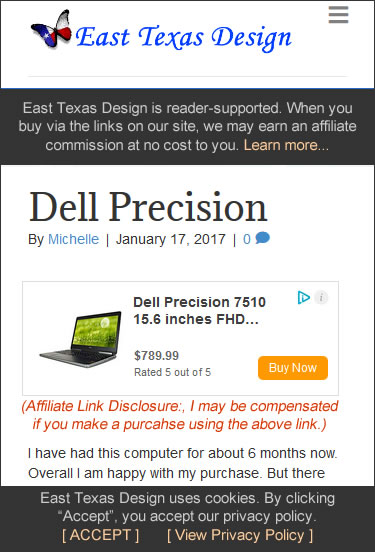Affiliate Marketing – What are the actual requirements?
If you are serious about being compensated for endorsing products through an affiliate program, there are some things you need to know.
- Affiliate marketing is not a “get rich quick” scheme. It is a waste of time to jump in before you have built a reputation and created a following.
- Be selective in what you promote. Your reputation is on the line. You don’t want to be known as the person who got rich helping CompanyX sell worthless or dangerous goods to unsuspecting families.
- There are rules! Individual affiliate programs and even the FTC (Fair Trade Commission) have rules in place to protect the companies and the consumers.
Actual Requirements:
The best way to make sure you are playing by the rules is to read the FTC’s current Endorsement Guidelines, along with any policies and agreements from any programs in which you participate.
FTC Guidelines
As of January 1, 2020, the FTC website states that your affiliate relationship:
- Should be disclosed “clearly and conspicuously on your site.”
- Should not be “below your review or below the link … so readers would have to keep scrolling after they finish reading.”
- “Consumers should be able to notice the disclosure easily. They shouldn’t have to hunt for it.”
They even give an example of what your disclosure could look like:
I get commissions for purchases made through links in this post.
My Interpretation
It looks like the smart thing would be to put a disclosure at the top of any pages that contain affiliate links or other paid endorsements.
I believe in transparency. But the majority of my website visitors on mobile devices. I do not want to add yet another thing “above the fold.”
There are other requirements. But I don’t want to spread any misinterpretations, so I’ll leave you to read the rest.
Amazon.com’s Guidelines
Amazon’s Program Operating Agreement, updated January 1, 2020, gives this specific example of what you could write:
As an Amazon Associate I earn from qualifying purchases.
Once again, I do not want to share any misinterpretations, so I will leave my fellow Amazon Associates to read the terms for themselves. I will say that I prefer this to the lengthy statement I have seen on other Amazon Affiliates’ websites.
My Interpretation
Nothing in Amazon’s guidelines sounds very far-fetched to me. They want me to follow the FTC’s rules and have been kind enough to provide me with some suggested text.
Although I like the short simplicity of Amazon’s sample text, I would prefer something more generic that links to a further explanation:
East Texas Design may earn a commission when you buy via the links on this site. Learn more…
What other website owners are doing
With all the rules and regulations that have come about these last few years, many website owners force visitors to click to accept cookies and scroll past affiliate disclosures and ads before reaching any real content.
Do you know what East Texas Design would look like if I did all that?

For the Amazon’s affiliate program, in particular, many website owners believe that the following statement must also appear in the sidebar or footer of every page that contains affiliate links:
East Texas Design is a participant in the Amazon Services LLC Associates Program, an affiliate advertising program designed to provide a means for sites to earn advertising fees by advertising and linking to amazon.com.
This is too much! I believe in transparency. I want readers know when I’m compensated for their actions. But it distracts from the website viewing experience.
